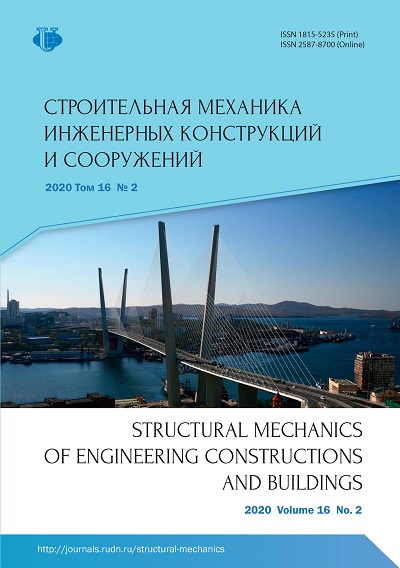The mechanism of nanostructuring the surface of engineering parts during shot blasting
- Authors: Kolmogorov G.L.1, Vysotin A.S.1
-
Affiliations:
- Perm National Research Polytechnic University
- Issue: Vol 16, No 2 (2020)
- Pages: 146-151
- Section: Dynamics of structures and buildings
- URL: https://journals.rudn.ru/structural-mechanics/article/view/23599
- DOI: https://doi.org/10.22363/1815-5235-2020-16-2-146-151
Cite item
Full Text
Abstract
Relevance. The paper considers shot blasting, which is a widely used method for improving the surface properties of parts (such as fatigue strength, hardness, and elongation) due to cold plastic deformation, which results in nanostructuring of the surface of the processed material, accompanied by a reduction in the grain size of its crystal structure. The conditions for the formation of a nanostructured surface layer when processing parts with a shot stream are studied. The aim of the work is to determine the conditions of nanostructuring during shot blasting due to plastic deformation, determined by the impact of the shot, which collides with the treated surface at high speed. Methods. To solve the stated problems, we used the solution of the contact problem of the theory of elasticity on the action of a concentrated force on the elastic half-space, the role of which is played by the workpiece. The conditions of the onset of plastic deformation in the surface layers of the workpiece are determined. Cold plastic deformation provides nanostructuring of the surface layer of the workpiece, increasing strength, fatigue life, atomic diffusion and improving tribotechnical characteristics. Results. Based on the contact problem of the theory of elasticity, the problem of the formation of a nanostructured layer on the surface of the workpiece during shot blasting has been solved. An analytical dependence has been obtained, which allows predicting the transition of the material to a plastic state and nanostructuring the surface of the workpiece during shot blasting.
About the authors
German L. Kolmogorov
Perm National Research Polytechnic University
Author for correspondence.
Email: vysotin.dpm@mail.ru
Dr. Sci. (Eng.), Professor of the Dynamics and Strength of Machine Department, Honored Worker of the Higher School of the Russian Federation
29 Komsomolskii Ave, Perm, 614000, Russian FederationAlexandr S. Vysotin
Perm National Research Polytechnic University
Email: vysotin.dpm@mail.ru
graduate student of the Dynamics and Strength of Machine Department
29 Komsomolskii Ave, Perm, 614000, Russian FederationReferences
- Kuznetsov N.D., Tseytlin V.I., Volkov V.I. Tekhnologicheskie metody povysheniya nadyozhnosti detalej mashin [Technological methods to improve the reliability of machine parts]. Moscow, Mashinostroenie Publ.; 1993. (In Russ.)
- Kirpichev V.A., Bukatyy A.S., Chirkov A.V. Prediction of fatigue resistance of surface-hardened smooth parts. News of higher educational institutions. Povolzhskiy region. Technical Science. 2012;3(23):102–109. (In Russ.)
- Evstigneev M.I., Podzey A.V., Sulima A.M. Tekhnologiya proizvodstva dvigatelej letatel’nyh apparatov [Production technology of aircraft engines]. Moscow, Mashinostroenie Publ.; 1982. (In Russ.)
- Sulima A.M., Shulov V.A., Yagodkin Yu.D. Poverhnostnyj sloj i ekspluatatsionnye svojstva detalej mashin [Surface layer and operational properties of machine parts]. Moscow, Mashinostroenie Publ.; 1988. (In Russ.)
- Surgutanov N.A. Modelirovanie i opredelenie zakonomernostei razvitiya treschini ustalosti v poverhnostnom sloe uprochnennih detalei [Modeling and determination of patterns of fatigue crack development in the surface layer of hardened parts] (PhD Diss.). Samara; 2019. (In Russ.)
- Lavrinenko Y.A. Experimental verification of the stress-strain state of compression springs during reinforcing operations. News of Tula State University. Technical science. 2017;9(1):444–449. (In Russ.)
- Kostichev V.E. The use of dynamic modeling to assess the effect of hardening treatment on fatigue resistance. Bulletin of the Samara State Aerospace University named after academician S.P. Korolev (National Research University). 2015;1(14, Part 1):147–153. (In Russ.)
- Vakulyuk V.S., Sazanov V.P. Analysis of the influence of the surface hardening scheme of samples with fillets on the distribution of residual stresses in a dangerous section. Bulletin of USATU. 2014;18(1–62):48–52. (In Russ.)
- Mahagaonkar S., Brahmankar P., Seemikeri C. Effect on Fatigue Performance of Shot Peened Components: An Analysis Using Doe Technique. Int. J. Fatig. 2009;(31): 693–702.
- Denisov A.S., Verkhutov A.A., Videneev A.A., Yudin V.M. Assessment of changes in the bearing capacity of the crankshaft in the process of fatigue failure. Technical regulation in transport construction. 2016;2(16):64–67. (In Russ.)
- Sharkov O.V., Zolotov I.A., Kalinin A.V. Prediction of fatigue life of machine parts using the finite element method. Proceedings of the Kaliningrad Technical University. 2014;35:209–218. (In Russ.)
- Maryina N.L. The stress concentration in the crankshaft under conditions of surface plastic deformation. Modern materials. Technics and technology. 2016;1(4):142–145. (In Russ.)
- Zaydes S.A., Ngo K.K. A modern approach to determining the stress state in the deformation zone under local loading. News of higher educational institutions. Engineering. 2016;7(676):56–63. (In Russ.)
- Prezo T., Mueller T., Samuel J. Obrabotka poverhnosti metallicheskoi detali [Surface Treatment of Metal Part]. Patent RF, no. 2579323; 2016. (In Russ.)
- Todaka Y., Umemoto M., Yamazaki A., Wang C., Tsuchiya K., Watanabe Y. Formation of surface nanocrystalline structure in steels by shot peening and role of strain gradient on grain refinement by deformation. ISIJ International. 2007;47(1):157–162.
- Bezukhov N.I. Osnovy teorii uprugosti, plastichnosti i polzuchesti [Fundamentals of the theory of elasticity, plasticity and creep]. Moscow, Vysshaya shkola Publ.; 1951. (In Russ.)
- Kolmogorov G.L., Korionov M.A., Vysotin A.S. Sposob formirovaniya szhimayushchih ostatochnyh napryazhenij pri drobestrujnoj obrabotke detalej [The method of forming compressive residual stresses during shot blasting of parts]. Patent RF, no. 2704341; 2019. (In Russ.)
















